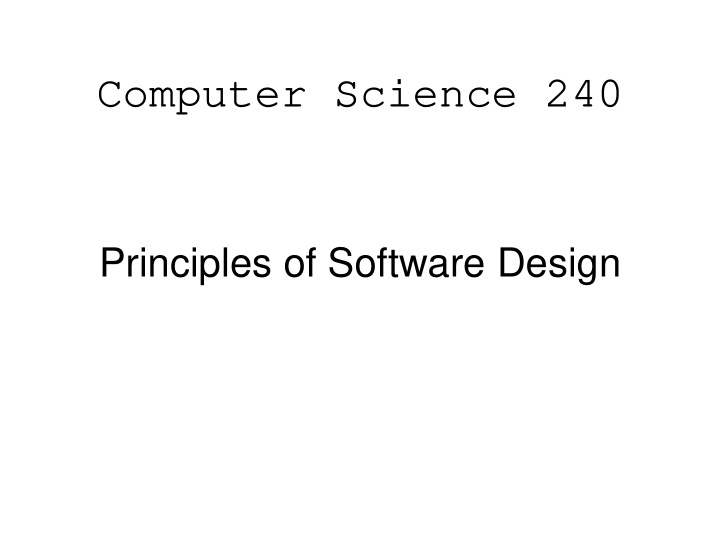



Computer Science 240 Principles of Software Design
Goals of Software Design • Create systems that – Work – Easy as possible to understand, debug, and maintain – Hold up well under changes – Have reusable components
Design is inherently iterative • Design, implement, test, Design, implement, test, … • Feedback loop from implementation back into design provides valuable knowledge • Designing everything before beginning implementation doesn’t work • Beginning implementation without doing any design also doesn’t work • The appropriate balance is achieved by interleaving design and implementation activities in relatively short iterations
Abstraction • Abstraction is one of the software designer’s primary tools for coping with COMPLEXITY • Programming languages and OSes provide abstractions that model the underlying machine • Programs written solely in terms of these low-level abstractions are very difficult to understand • Software designers must create higher-level, domain- specific abstractions, and write their software in terms of those – High-level abstractions implemented in terms of low-level abstractions
Abstraction • Some abstractions correspond to “real world” concepts in the application domain – Examples: Bank, Customer, Account, Loan, Broker, … • Other abstractions do not correspond to “real world” domain concepts, but are needed for internal implementation – Examples: HttpServer, Database, HashTable, …
Abstraction • Each abstraction is represented as a class • Each class has a carefully designed public interface that defines how the rest of the system interacts with it • A client can invoke operations on an object without understanding how it works internally • This is a powerful technique for reducing the cognitive burden of building complex systems
Naming • A central part of abstraction is giving things names (or identifiers) • Selecting good names for things is critical • Class, method, and variable names should clearly convey their function or purpose • Class and variable names are usually nouns • Method names are usually verbs – Exceptions • Object properties (ID, Name, Parent, etc.) • Event handlers (MouseMoved, UserLoggedIn)
Cohesion / Single Responsibility • Each abstraction should have a single responsibility • Each class should represent one, well-defined concept – All operations on a class are highly related to the class’ concept • Each method should perform one, well-defined task – Unrelated or loosely related tasks should be in different methods • Cohesive classes and methods are easy to name
Abstracting All the Way • Some abstractions are simple enough to store directly using the language’s built-in data types – Name => string – Pay Grade => int – Credit Card => string • Often it is best to create classes for such simple abstractions for the following reasons: – Data validation – Related operations – Code readability
Decomposition • In addition to Abstraction, Decomposition is the other fundamental technique for taming COMPLEXITY • Large problems subdivided into smaller sub- problems • Subdivision continues until leaf-level problems are simple enough to solve directly • Solutions to sub-problems are recombined into solutions to larger problems
Decomposition • Decomposition is strongly related to Abstraction • The solution to each sub-problem is encapsulated in its own abstraction (class or subroutine) • Solutions to larger problems are concise because they’re expressed in terms of sub-problem solutions, the details of which can be ignored • The decomposition process helps us discover (or invent) the abstractions that we need
Decomposition • Levels of decomposition – System – Subsystem – Packages – Classes – Routines • Hypo- and Hyper-Decomposition • When have we decomposed far enough? – Size metrics – Complexity metrics – Single responsibility
Algorithm & Data Structure Selection • No amount of decomposition or abstraction will hide a fundamentally flawed selection of algorithm or data structure.
Minimize Dependencies • Dependencies – Class A CALLS Class B – Class A HAS MEMBER OF Class B – Class A INHERITS FROM Class B
Minimize Dependencies • Minimizing the number of interactions between different classes has several benefits: – A class with few dependencies is easier to understand – A class with few dependencies is less prone to ripple effects – A class with few dependencies is easier to reuse
Minimize Dependencies • When classes must interact, if possible they should do so through simple method calls – This kind of dependency is clear in the code and relatively easy to understand
Separation of Interface and Implementation • Maintain a strict separation between a class’ interface and its implementation • This allows internal details to change without affecting clients • interface Stack + class StackImpl • Program to interfaces instead of concrete classes
Information Hiding • Many languages provide “public”, “private”, and “protected” access levels • All internal implementation is “private” unless there’s a good reason to make it “protected” or “public” • A class’ public interface should be as simple as possible
Information Hiding • Don’t let internal details “leak out” of a class – ClassRoll instead of StudentLinkedList • Some classes or methods are inherently tied to a particular implementation. For these it is OK to use an implementation-specific name – HashTable – TreeSet
Code Duplication • Code duplication should be strenuously avoided – Identical or similar sections of code • Disadvantages of duplication: – N copies to maintain – Bugs are duplicated N times – Makes program longer, decreasing maintainability • Solutions – Factor common code into a separate method or class – Shared code might be placed in a common superclass
Recommend
More recommend